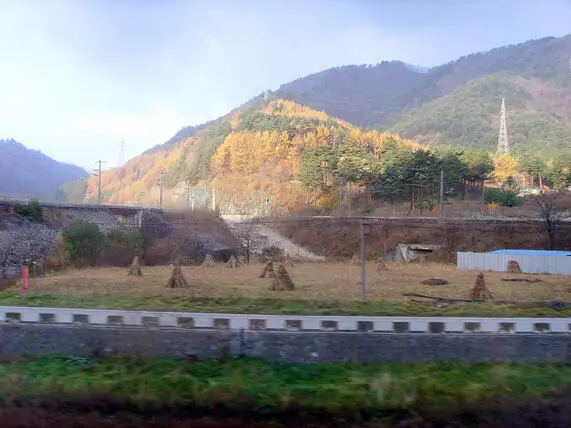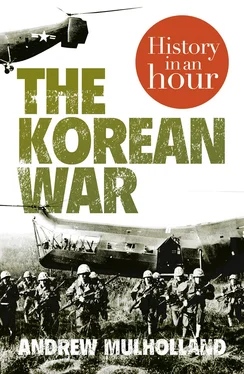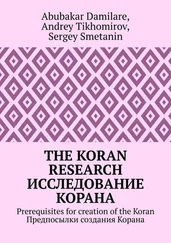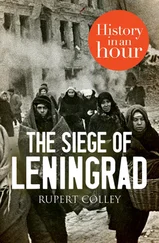The climate may best be described as hostile. The summers are hot and dry, the winters terribly cold. Between the two, spring rains can turn much of the landscape to mud.
In 1950, transport links were primitive, with very few roads or railways and only two major ports. These were at Pusan on the southeast tip and Inchon, serving the capital city of Seoul, midway up the west coast. They would become crucial during the war.

The Taebaek Mountains (Image by G43)
The Korean language, food and mindset are unlike those of China or Japan. Such distinctions took shape through geographical isolation. From pre-history, the peninsula was relatively self-contained. Linguistically, for instance, Korean is generally accepted to be a unique language, completely unrelated to those of its neighbours. Most scholars regard the overlap with Japanese as a later phenomenon brought about through contact. Although food is based on rice, vegetables and fish, the cooking styles are not those of northern China. The same is true of religion (with a strong Shamanistic tradition), architecture, music and dance.
Once Korea’s history became dominated by neighbouring states, however, this cultural purity began to be diluted and cross-pollinated. For example, spoken Korean (and its precursor dialects) was first transposed into the Chinese Hanja script. The culture, therefore, reflects the geography and supports the idea of Korea as a ‘natural state’. For these reasons, despite a difficult history and continuing division, this is a region with a strong national identity, maintained in the face of frequent conquest.

Korean end-roof tile from 5th or 6th century (Image by pressapochista)
Korea was repeatedly invaded by China from about 200 BC. In 1219 it was the turn of the Mongols, with Genghis Khan leading the first of four large incursions by these fierce nomadic warriors. By the sixteenth century, Japan had emerged as a powerful regional player and it too sought the conquest of the peninsula. The result was devastation, widespread slaughter, economic and agricultural collapse. Little surprise, then, that by the early nineteenth century, Korea had become something of a hermit nation, anxious to minimize contact with outside cultures.
Under the Joseon dynasty this policy worked for a time, with a period of relative tranquillity and prosperity. Chinese suzerainty was formally acknowledged, but without onerous conditions. The growing imperial ambitions of Japan and Russia, however, combined with their superior technology and large armed forces, would shortly undermine this wish to be left alone.
In 1876 the Joseons signed an overtly exploitative treaty with Japan, granting her significant trading rights. Six years later, in what for a time proved a shrewd piece of diplomacy, Korea signed a treaty with the United States. Brokered by China, this deal helped to offset the influence of the Japanese, who were already basing troops in Korea. Tensions were high, as China and Japan controlled different factions within the weak Korean government. In 1885, both China and Japan agreed to withdraw all of their forces from the peninsula. Yet when in 1894 the Korean emperor requested Chinese assistance in putting down a rebellion, Japan used this as a pretext to send an expeditionary force of her own. This resulted in the First Sino-Japanese War.
Within nine months China had capitulated and Japan’s influence in Korea became even stronger. Now though, she found she had another major power competing for influence in the region: Russia. As early as 1896 at the coronation of Tsar Nicholas II, the Japanese had proposed the formal division of Korea, into zones of Russian and Japanese ‘influence’. Foreshadowing things to come, a dividing line was suggested along the 38th Parallel. The Russians were interested in the area for strategic reasons. They had no warm water port on the Pacific Ocean. The large Russian naval base at Vladivostok froze during the winter. Port Arthur in Chinese Manchuria was different – it remained open. It was an excellent natural harbour and fortress and, indeed, had been briefly seized by Japan. Direct military threats from Britain and France had eventually forced her to return it to China.
The Korean peninsula lies between Vladivostok and Port Arthur. The Russians leased Port Arthur from China in 1898 and built a railway connecting it to Harbin in China and thence Vladivostok, running along the northern border of Korea. The components were in place for increasing rivalry with Japan.
After years of fruitless negotiation, Japan attacked Russia in 1904 and inflicted a devastating defeat on the Tsar’s armies and fleet. She now emerged as the dominant military power in the region. A corollary of that was the eventual full colonization of Korea. It was the USA, also an emerging power during this period, that oversaw the 1905 Treaty of Portsmouth which facilitated this. In exchange, President Theodore Roosevelt is alleged to have secured tacit Japanese acceptance of US dominance in the Philippines. Article Two of the treaty explicitly recognized that Japan had ‘paramount political, military and economical interests’ in Korea. That same year, the Japanese forced Korea to accept a ‘Protectorate Treaty’, followed in 1911 by the ‘Japan-Korea Annexation Treaty’. These were not signed by the Korean emperor, but their dubious legal standing did not prevent Japan from taking complete control.
Japanese rule in Korea was brutal and totalitarian. In essence, the ambition was to eradicate the Korean culture and supplant it with Japan’s own, extending to language, the legal system and religion. The animosities which this regime was to engender would last way beyond the Second World War. Between 1941 and 1945, Japan ruthlessly exploited its colony for raw materials as well as men and women, forced to serve as soldiers and prostitutes for the Imperial Japanese Army. As the war drew to a close and Japan’s imminent defeat became inevitable, the Allied powers turned to consider the break-up of her empire.
After the Second World War: Two Koreas Emerge
As the Second World War drew to a close, the Allies turned their attention to the future status of those areas which had been under Axis control. Between 1945 and the outbreak of the Korean War in June 1950, Korea would be divided into two. By 1950 there was a Russian-dominated Communist North Korea and a US-dominated quasi-democratic South Korea.
It was the Americans who proposed the division of the peninsula into two, along the 38th Parallel. North of this line would become a Russian-controlled zone, with the Americans occupying the south. There is nothing particularly special about the 38th Parallel, other than it being an internationally recognized line on the map. It happens to run across the waist of Korea and the Americans noticed that if it were used in this way, the southern zone would include the capital city of Seoul, and both of the country’s major ports.
Such a slicing up of the map by the great powers was commonplace at the time. Little real account was taken of the interests or aspirations of the local inhabitants. From an American perspective this was a bold proposal, in that the Russians were likely to emerge as the more powerful player in the region. Russia had undertaken to attack Japan within three months of the defeat of Nazi Germany. The obvious means of doing this would be to invade Japanese-occupied Manchuria, including Port Arthur and the Chinese border with Korea. They could then move south into Korea. This is what transpired. Other allied forces in Asia (chiefly American and British) were thinly spread. It would be months before any kind of garrison could be sent to the south of Korea.
Читать дальше














